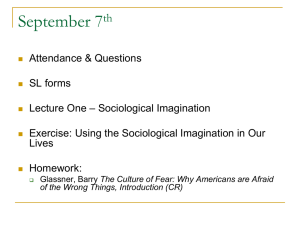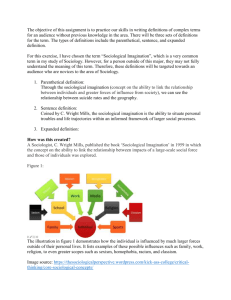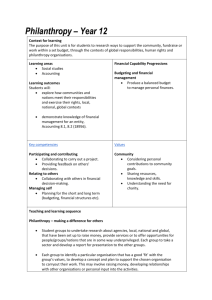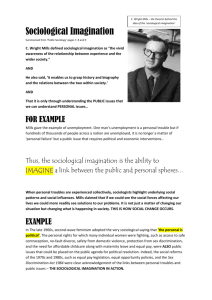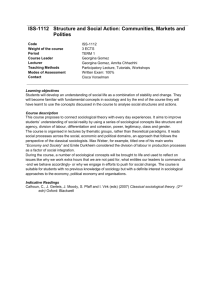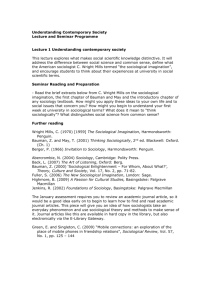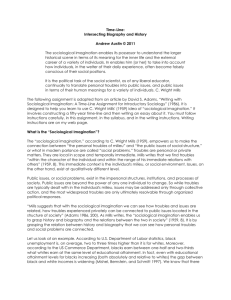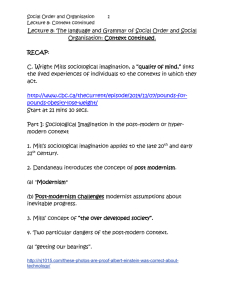Lecture 5: The language and Grammar of Social
advertisement
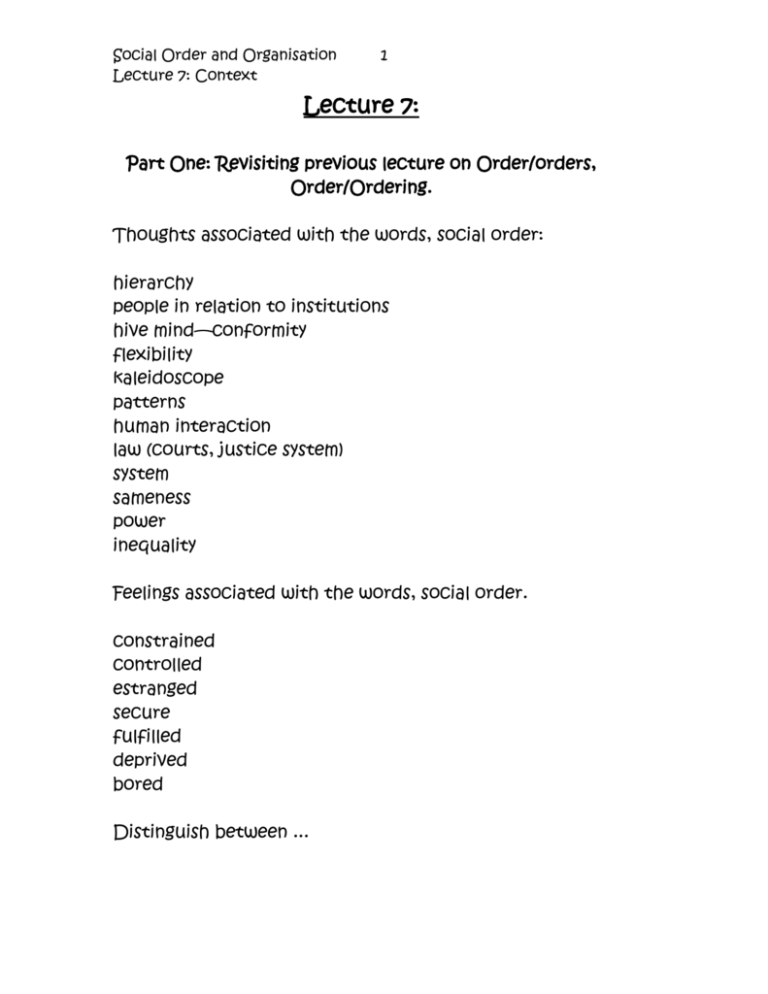
Social Order and Organisation Lecture 7: Context 1 Lecture 7: Part One: Revisiting previous lecture on Order/orders, Order/Ordering. Thoughts associated with the words, social order: hierarchy people in relation to institutions hive mind—conformity flexibility kaleidoscope patterns human interaction law (courts, justice system) system sameness power inequality Feelings associated with the words, social order. constrained controlled estranged secure fulfilled deprived bored Distinguish between ... Social Order and Organisation Lecture 7: Context 2 (a) a more neutral focus on social order/ordering as recurring patterns/patterning of human interaction. and (b) a more evaluative focus on particular social orders/orderings. Specific recurring patterns of interaction have specific effects: Part Two: The Importance of Context. Review ... *The Paradox of freedom and constraint. *Locating social order/organization in between freedom (agency) and constraint (structures). 1. The language of social order: context, social actors, social action, social interaction, social institutions, 2. CONTEXT: 3. TO what context refers and how we understand it in sociological studies. 4. The relationship between context and meaning. "Count for me, Monica" 5. C. Wright Mills argues that events and human experiences must be understood in social context. “Neither the life of an individual nor the history of a society can be understood without understanding both.” Social Order and Organisation Lecture 7: Context 3 a. The context could be historical; economic; political; cultural; organizational; geographical etc. b. The essence of the SOCIOLOGICAL IMAGINATION is the ability to link biography with history within society. c. A SOCIOLOGICAL IMAGINATION is exercised through making a distinction between “the personal troubles of milieu” and the “public issues of social structure.” troubles = issues = EXAMPLES: *my overweight child versus obesity http://www.cbc.ca/fifth/episodes/2012-2013/the-secretsof-sugar d. Mills sociological imagination is a “quality of mind.” e. Mills illustrates these ideas through his discussion of unemployment, marriage, and the city. f. Linking personal troubles to public issues help us to understand how our lives are linked to the lives of others. h. This understanding will allow “human reason to play a greater role in human affairs.” Social Order and Organisation Lecture 7: Context 4 h. A quality of mind that informs the actions of all citizens of society in the modern world. 6. How context is used in sociological studies: Mills way of exercising the sociological imagination locates people’s experience in any number of contexts. e.g. "In The Ghetto." REFER TO KIT READINGS ON NEIGHBOURHOODS http://www.youtube.com/watch?v=6am8V5KNJ4A e.g. The geographical context of York University: See the Fifth Estate documentary "Lost In The Struggle: The Next Chapter" (2012) http://www.cbc.ca/fifth/episodes/2012-2013/lost-in-thestruggle-the-next-chapter 7. Ever Widening Contexts: David Ehrenfeld on the Cow Tipping Point: the role of context in shaping the knowledge that is made available to us. (a) Ehrenfeld's question and the narrow context of scientific answers: "... in most of these debates, it is wrong to confine the debate to narrow technical subjects: the right context is Social Order and Organisation Lecture 7: Context 5 usually much broader and far more accessible to the public."(p. 13 of reading.) (b) Vested interests are served when the focus is kept narrow. "By selecting the narrowest from many available contexts in which to evaluate their own actions, and by cloaking those actions in a haze of technological intricacy, they can get away with behaviour that society would not countenance if it were thinking clearly." (p. 13 of the reading) (c) Very narrow questions produce results that support the "status quo": (d) Ehrenfeld widens out the context from these narrow questions. (f) Examples of ever widening contexts The context of milk producers practices: The context of the ethical of animal treatment: The context of the welfare of dairy farmers The context of ecological bio-diversity and sustainability 7. CONCLUSION to Ehrenfeld's argument: The context through which we look at an issue, event or idea shapes our understanding of it including what and how much we know about it. Social Order and Organisation Lecture 7: Context 6 Lecture 7 CONCEPTS/QUOTES *the paradox of freedom and constraint * the "in between" *context, *social actor, *social action, *social interaction, *social institution, *context and meaning *linking biography with history within society, *the personal troubles of milieu, *public issues of social structure, *A quality of mind *the ever widening circle of context, Social Order and Organisation Lecture 7: Context 7 “Neither the life of an individual nor the history of a society can be understood without understanding both.” C. Wright Mills. "... in most of these debates, it is wrong to confine the debate to narrow technical subjects: the right context is usually much broader and far more accessible to the public."(Ehrenfeld p. 13 of reading.) "By selecting the narrowest from many available contexts in which to evaluate their own actions, and by cloaking those actions in a haze of technological intricacy, they can get away with behaviour that society would not countenance if it were thinking clearly." (Ehrenfeld p. 13 of the reading)
